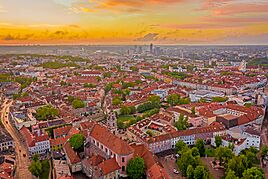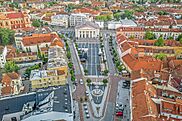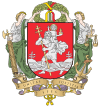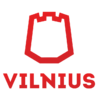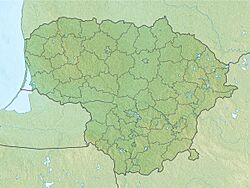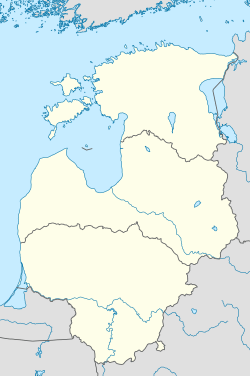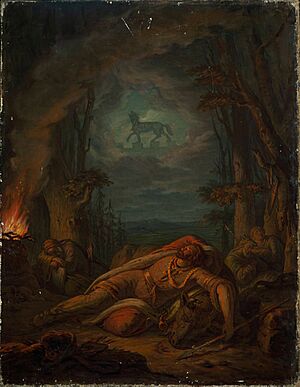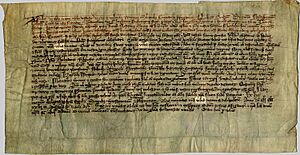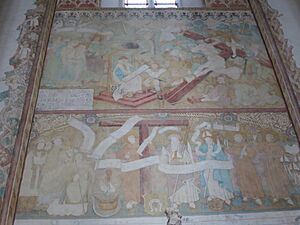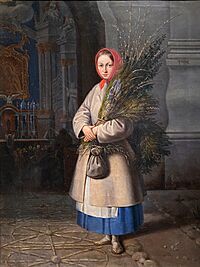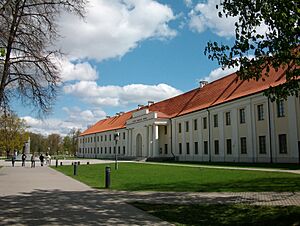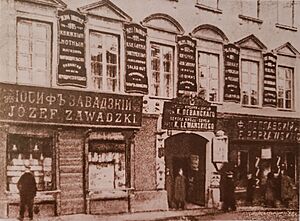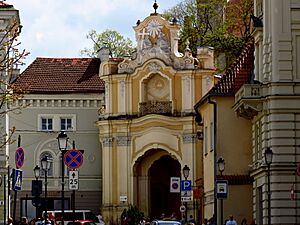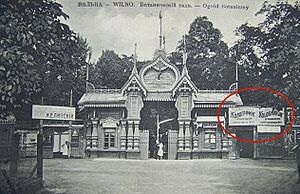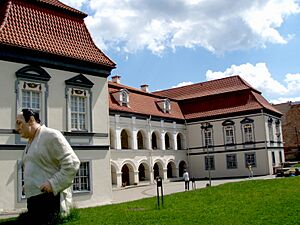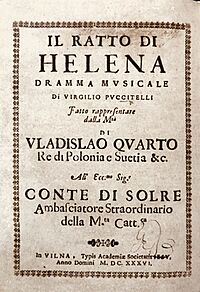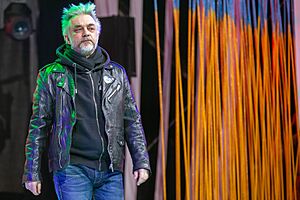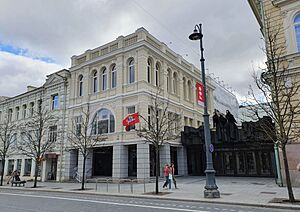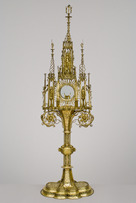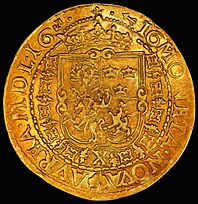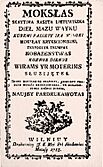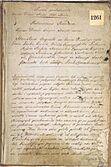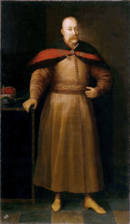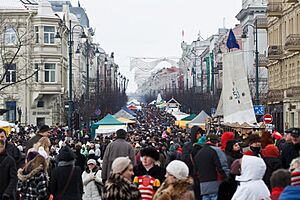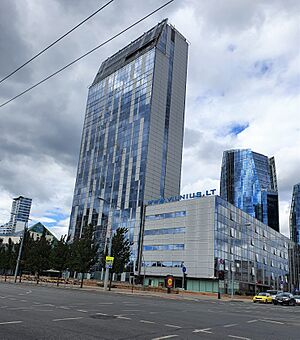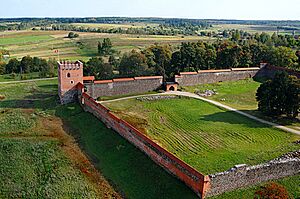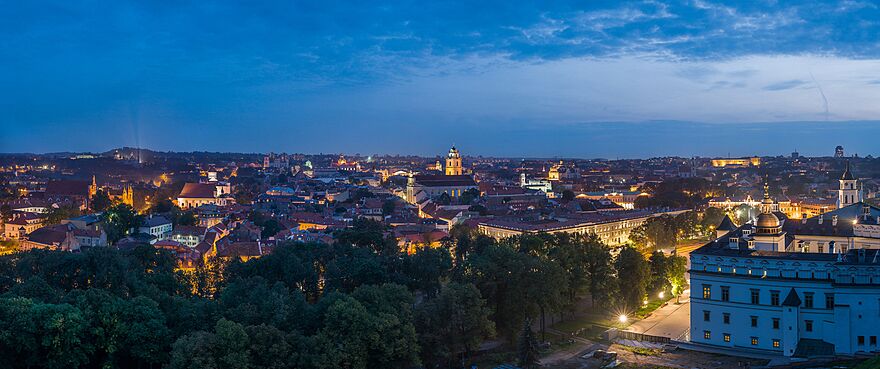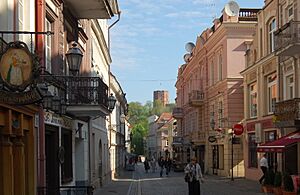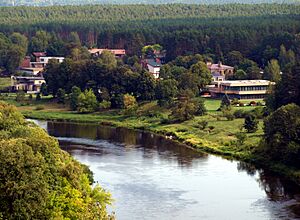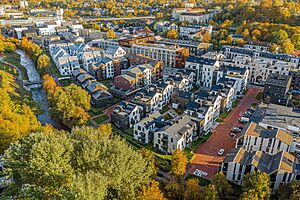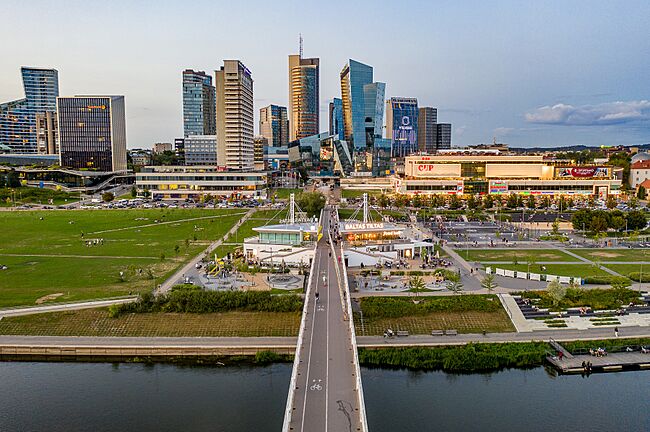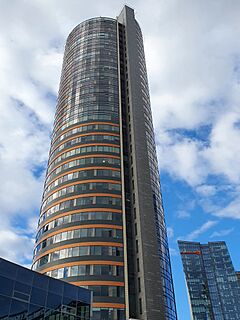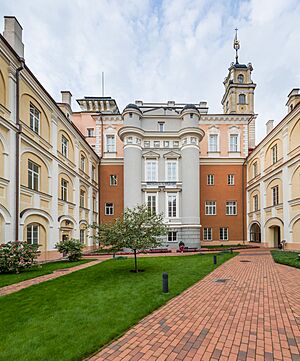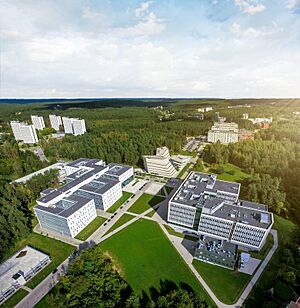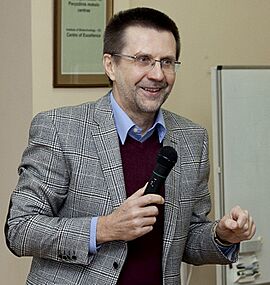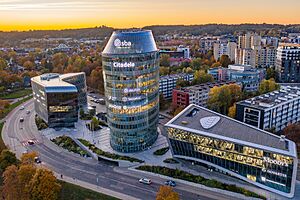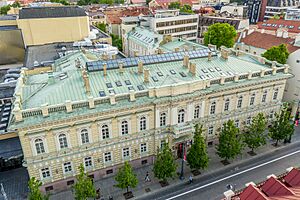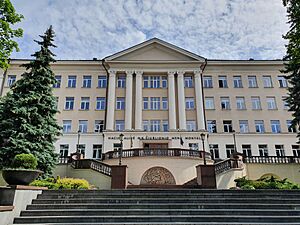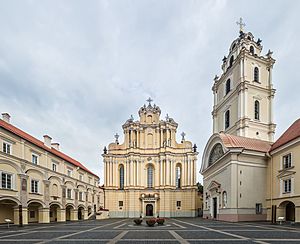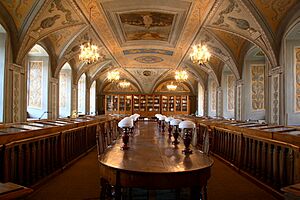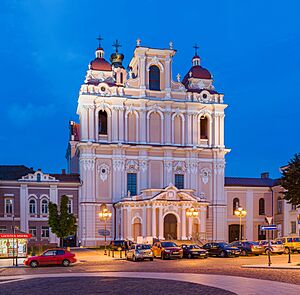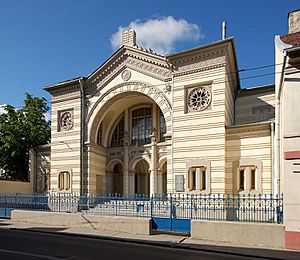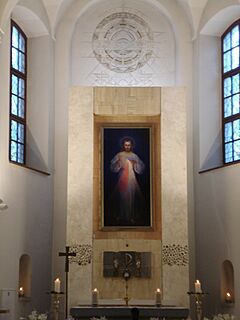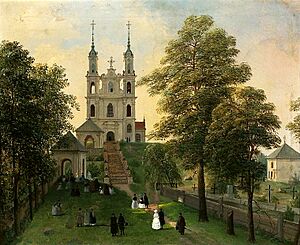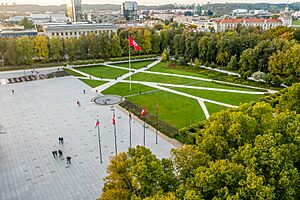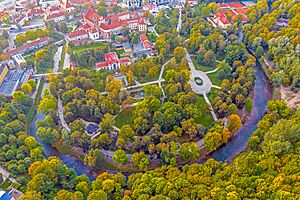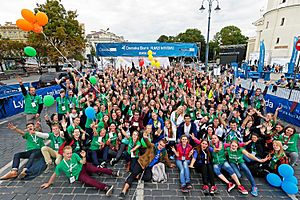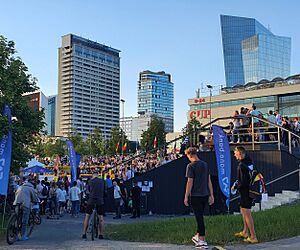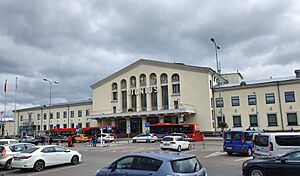Vilnius facts for kids
Quick facts for kids
Vilnius
|
|||||
|---|---|---|---|---|---|
|
Vilnius Cathedral and its bell tower
Gediminas Tower
Vilnius Central Business District
Presidential Palace
Church of St. Theresa and Gate of Dawn
Town Hall Square
|
|||||
|
|||||
| Nickname(s):
Jerusalem of the North, Rome of the North, Athens of the North, New Babylon, City of Palemon City of Low Flying Angels [1]
|
|||||
| Motto(s):
Unitas, Justitia, Spes
(Latin: Unity, Justice, Hope) |
|||||
| Country | |||||
| County | Vilnius County | ||||
| Municipality | Vilnius | ||||
| Capital of | Lithuania | ||||
| First mentioned | 1323 | ||||
| Granted city rights | 1387 | ||||
| Elderships |
List
Antakalnis
Fabijoniškės Grigiškės Justiniškės Karoliniškės Lazdynai Naujamiestis Naujininkai Naujoji Vilnia Paneriai Pašilaičiai Pilaitė Rasos Šeškinė Šnipiškės Verkiai Vilkpėdė Senamiestis (Old Town) Viršuliškės Žirmūnai Žvėrynas |
||||
| Government | |||||
| • Type | Mayor–council government | ||||
| • Body | City council | ||||
| Area | |||||
| • Capital city | 401 km2 (155 sq mi) | ||||
| • Urban | 350 km2 (140 sq mi) | ||||
| • Metro | 9,730 km2 (3,760 sq mi) | ||||
| Elevation | 112 m (367 ft) | ||||
| Population
(1 July 2024)
|
|||||
| • Capital city | 605,270 | ||||
| • Rank | (35th in EU) | ||||
| • Density | 1,560/km2 (4,000/sq mi) | ||||
| • Urban | 716,856 | ||||
| • Urban density | 2,000/km2 (5,000/sq mi) | ||||
| • Metro | 853,656 | ||||
| • Metro density | 93/km2 (240/sq mi) | ||||
| Demonym(s) | Vilnian | ||||
| GDP | |||||
| • Metro | €29.4 billion (US$31 billion) (2022) |
||||
| • Per capita | €35,300 (US$37,200) (2022) |
||||
| Time zone | UTC+2 (EET) | ||||
| • Summer (DST) | UTC+3 (EEST) | ||||
| Postal code |
01001–14191
|
||||
| Area code(s) | (+370) 5 | ||||
| City budget | €1.4 billion | ||||
| HDI (2021) | 0.913 – very high | ||||
| Climate | Dfb | ||||
| Official name: Historic Centre of Vilnius | |||||
| Type: | Cultural | ||||
| Criteria: | ii, iv | ||||
| Designated: | 1994 (18th session) | ||||
| UNESCO region: | Europe | ||||
Vilnius is the capital and largest city of Lithuania. It is also the second-biggest city in the Baltic states. In July 2024, about 605,270 people lived in Vilnius. The wider urban area had around 708,627 people.
Vilnius is famous for its beautiful Old Town. It is one of the largest and best-preserved old towns in Europe. In 1994, UNESCO named it a World Heritage Site. The city has a special building style called Vilnian Baroque. It is the most eastern Baroque city and the largest one north of the Alps.
Long ago, Vilnius was known for having many different cultures. People even compared it to ancient Babylon. Before World War II, Vilnius was a very important center for Jewish people in Europe. Because of its strong Jewish influence, it was called "the Jerusalem of Lithuania." Napoleon even called it "the Jerusalem of the North" when he visited in 1812.
In 2009, Vilnius was a European Capital of Culture along with Linz, Austria. In 2021, it was named one of the top 25 Global Cities of the Future. Vilnius is also a major financial center. It hosted the 2023 NATO Summit. Vilnius is part of Eurocities and the Union of Capitals of the European Union (UCEU).
Contents
- What's in a Name? The Story of Vilnius
- A Journey Through Time: The History of Vilnius
- Exploring the Land: Vilnius' Geography
- Weather in Vilnius: A Look at the Climate
- Art and Creativity: Vilnius' Culture
- Museums and Galleries: Discovering Vilnius' Treasures
- Stories and Books: Vilnius' Literature Scene
- Movies in Vilnius: A Cinematic Journey
- Sounds of the City: Music in Vilnius
- On Stage: Theatre in Vilnius
- Capturing Moments: Photography in Vilnius
- Skilled Hands: Crafts in Vilnius
- Speaking Through Time: Languages in Vilnius
- Dressing Up: Fashion in Vilnius
- Celebrating Together: Holidays and Festivals
- How Vilnius is Run: Administration
- City Views: Urbanism and Architecture
- People of Vilnius: Demographics
- Money and Innovation: Vilnius' Economy
- Learning in Vilnius: Education
- Faith and Beliefs: Religion in Vilnius
- Green Spaces and Landmarks: Parks, Squares, and Cemeteries
- Visiting Vilnius: Tourism
- Staying Active: Sports in Vilnius
- Getting Around: Transport in Vilnius
- Staying Healthy: Healthcare in Vilnius
- News and Entertainment: Media in Vilnius
- Global Connections: Twin Towns and Sister Cities
- Famous Faces: Notable People from Vilnius
- Images for kids
- See also
What's in a Name? The Story of Vilnius
The name Vilnius comes from the Vilnia river. In Lithuanian, Vilnia means ripple. Over time, the city's name has been spelled differently in many languages. Vilna was once a common English name for it. Other names include Wilno (Polish) and Vilnia (Belarusian).
A famous legend tells how Vilnius got its start. Around the 1530s, Grand Duke Gediminas (who lived from about 1275 to 1341) was hunting. He was in a special forest where the Vilnia river meets the Neris river. After a long hunt, he decided to sleep there.
Gediminas dreamed of a huge Iron Wolf howling loudly on a hill. When he woke up, he asked the chief priest, Lizdeika, to explain the dream. The priest said the Iron Wolf meant a new castle and city. This city would be the capital of Lithuania. Its fame would spread worldwide.
Gediminas followed the gods' message. He built two castles: the Lower Castle in the valley and the Crooked Castle on Bald Hill. He made Vilnius his capital. The city grew around these castles.
A Journey Through Time: The History of Vilnius
Vilnius has a very long history, going back to the Stone Age. Over the years, many different groups have ruled it. These include the Russian Empire, Soviet Union, Napoleonic France, and Nazi Germany.
Vilnius started as a settlement for Baltic people. It became very important in the Grand Duchy of Lithuania. The city was first mentioned in letters from Grand Duke Gediminas in 1323. He invited Jews and Germans to live there. He also built a wooden castle on a hill.
In 1387, Lithuania became Christian. Vilnius officially became a city. Many skilled workers and traders from different countries moved there. Vilnius was the capital of the Grand Duchy until 1795. It also served as the capital of the Polish–Lithuanian Commonwealth.
The city thrived under the Commonwealth. Vilnius University was founded in 1579 by King Stephen Báthory. Vilnius became a hub for culture and science. People from both the east and west came to live there. It had diverse communities, including Jewish, Orthodox, and German people. The city faced many invasions and occupations. These included attacks by the Teutonic Order, Russia, and later, Germany.
Under Russian rule, Vilnius became the capital of the Vilna Governorate. In the 19th and early 20th centuries, different cultural groups, like Jews, Poles, Lithuanians, and Belarusians, saw their cultures revive. After World War I, Poland and Lithuania fought over the city. Poland occupied it. Then, the Soviet Union took it over during World War II. After the war, Vilnius became the capital of the Lithuanian Soviet Socialist Republic.
Becoming Independent: Vilnius Today

On March 11, 1990, Lithuania declared its independence from the Soviet Union. In January 1991, Soviet troops attacked Vilnius. They targeted the State Radio and Television Building and the Vilnius TV Tower. This attack killed 14 civilians. The Soviet Union finally recognized Lithuania's independence in September 1991. Lithuania's constitution states that Vilnius is its "long-standing historical capital."
Vilnius has grown into a modern European city. Its area has expanded since 1990. It now includes more urban areas, villages, and even the town of Grigiškės. Many old buildings have been restored. A new business area, the Vilnius Central Business District, has developed north of the Neris river. This area has modern homes and shops. The municipal building and the tall 148.3 m (487 ft) Europa Tower are key landmarks there.
The construction of Swedbank's headquarters shows how important Scandinavian banks are in Vilnius. The Vilnius Business Harbour complex has also grown. Between 1995 and 2018, over 75,000 apartments were built. This made Vilnius a leader in construction among Baltic cities.
Vilnius was a European Capital of Culture in 2009. It shared this title with Linz, Austria. A financial crisis in 2007–2008 affected tourism. This meant some projects could not be finished. There were also claims of corruption and protests over tax increases. In 2013, Vilnius hosted the Eastern Partnership summit. Many European leaders attended. In 2015, Remigijus Šimašius became the city's first directly elected mayor. The 2023 NATO summit was held in Vilnius.
Exploring the Land: Vilnius' Geography
Vilnius is located in southeastern Lithuania. It sits where the Vilnia and Neris rivers meet. Some countries claim to have the geographical center of Europe. The Guinness Book of World Records recognizes a spot near Vilnius as this center. In 1989, a French institute calculated the center of Europe. It found the spot near the village of Girija, about 26 kilometers from Vilnius. A monument was built there in 2004. It is a white granite column with a crown of stars.
Vilnius is 312 km (194 mi) from the Baltic Sea. It is also 312 km (194 mi) from Klaipėda, Lithuania's main seaport. Roads connect Vilnius to other big Lithuanian cities. These include Kaunas (102 km or 63 mi away), Šiauliai (214 km or 133 mi away), and Panevėžys (135 km or 84 mi away).
The city of Vilnius covers 402 km2 (155 sq mi). Buildings make up 29.1 percent of the city. Green spaces cover 68.8 percent, and water covers 2.1 percent. Vilnius has eight nature reserves. These areas protect special landforms, rivers, and landscapes.
Weather in Vilnius: A Look at the Climate
Vilnius has a humid continental climate. This means it has warm summers and cold winters. Weather records have been kept since 1777. The average yearly temperature is 7.3 °C (45 °F). In January, the average is −3.9 °C (25 °F). In July, it is 18.7 °C (66 °F). The city gets about 691 mm (27.20 in) of rain each year. Temperatures have risen a lot in the last 30 years. Experts believe this is due to global warming.
Summer days are usually warm or hot. In July and August, temperatures can go above 30 °C (86 °F) during heat waves. People enjoy outdoor cafes and restaurants.
Winters can be very cold. Temperatures can drop below −25 °C (−13 °F) every other year. The rivers in Vilnius freeze in cold winters. Lakes around the city are almost always frozen from December to March. Sometimes they stay frozen until April. The Lithuanian Hydrometeorological Service in Vilnius watches the country's climate.
| Climate data for Vilnius (1991–2020 normals, sun 1961–1990, extremes 1777–present) | |||||||||||||
|---|---|---|---|---|---|---|---|---|---|---|---|---|---|
| Month | Jan | Feb | Mar | Apr | May | Jun | Jul | Aug | Sep | Oct | Nov | Dec | Year |
| Record high °C (°F) | 12.3 (54.1) |
14.4 (57.9) |
24.7 (76.5) |
29.0 (84.2) |
31.8 (89.2) |
34.2 (93.6) |
36.4 (97.5) |
34.9 (94.8) |
33.1 (91.6) |
24.5 (76.1) |
15.5 (59.9) |
10.5 (50.9) |
36.4 (97.5) |
| Mean maximum °C (°F) | 4.9 (40.8) |
5.7 (42.3) |
13.1 (55.6) |
22.4 (72.3) |
26.7 (80.1) |
28.8 (83.8) |
30.8 (87.4) |
30.3 (86.5) |
25.4 (77.7) |
18.3 (64.9) |
11.1 (52.0) |
6.1 (43.0) |
32.1 (89.8) |
| Mean daily maximum °C (°F) | −1.7 (28.9) |
−0.5 (31.1) |
4.4 (39.9) |
12.6 (54.7) |
18.4 (65.1) |
21.7 (71.1) |
23.8 (74.8) |
23.1 (73.6) |
17.4 (63.3) |
10.3 (50.5) |
3.7 (38.7) |
−0.3 (31.5) |
11.1 (52.0) |
| Daily mean °C (°F) | −3.8 (25.2) |
−3.1 (26.4) |
0.9 (33.6) |
7.6 (45.7) |
13.0 (55.4) |
16.4 (61.5) |
18.7 (65.7) |
17.9 (64.2) |
13.0 (55.4) |
7.1 (44.8) |
1.9 (35.4) |
−2.1 (28.2) |
7.3 (45.1) |
| Mean daily minimum °C (°F) | −5.9 (21.4) |
−5.6 (21.9) |
−2.7 (27.1) |
2.6 (36.7) |
7.5 (45.5) |
11.1 (52.0) |
13.6 (56.5) |
12.7 (54.9) |
8.5 (47.3) |
3.9 (39.0) |
0.0 (32.0) |
−4 (25) |
3.5 (38.3) |
| Mean minimum °C (°F) | −19.3 (−2.7) |
−17.5 (0.5) |
−10.8 (12.6) |
−4.2 (24.4) |
0.1 (32.2) |
4.9 (40.8) |
8.1 (46.6) |
6.8 (44.2) |
1.1 (34.0) |
−3.8 (25.2) |
−8.7 (16.3) |
−14.1 (6.6) |
−22.0 (−7.6) |
| Record low °C (°F) | −37.2 (−35.0) |
−35.8 (−32.4) |
−29.6 (−21.3) |
−14.4 (6.1) |
−4.4 (24.1) |
0.1 (32.2) |
3.5 (38.3) |
1.0 (33.8) |
−4.8 (23.4) |
−14.4 (6.1) |
−22.8 (−9.0) |
−30.5 (−22.9) |
−37.2 (−35.0) |
| Average precipitation mm (inches) | 38.9 (1.53) |
34.4 (1.35) |
37.0 (1.46) |
46.2 (1.82) |
52.1 (2.05) |
72.7 (2.86) |
79.3 (3.12) |
75.8 (2.98) |
65.2 (2.57) |
51.5 (2.03) |
51.5 (2.03) |
49.2 (1.94) |
653.8 (25.74) |
| Average precipitation days | 21.7 | 18.4 | 17.5 | 10.2 | 12.4 | 11.7 | 11.4 | 10.5 | 9.7 | 13.5 | 16.7 | 21.2 | 174.9 |
| Average dew point °C (°F) | −5 (23) |
−5 (23) |
−3 (27) |
1 (34) |
6 (43) |
10 (50) |
13 (55) |
12 (54) |
9 (48) |
4 (39) |
0 (32) |
−3 (27) |
3 (38) |
| Mean monthly sunshine hours | 37 | 70 | 117 | 165 | 242 | 231 | 220 | 217 | 141 | 93 | 33 | 25 | 1,591 |
| Average ultraviolet index | 0 | 1 | 2 | 3 | 5 | 6 | 6 | 5 | 3 | 2 | 1 | 0 | 3 |
| Source: WMO (avg high and low) NOAA (sun, extremes), Météo Climat, Time and Date (dewpoints, 1985–2015) and Weather Atlas | |||||||||||||
Art and Creativity: Vilnius' Culture
Vilnius was a major art center in the Grand Duchy of Lithuania. Artists from all over Europe came here. The oldest artworks are from the 14th century. These include paintings for churches and religious books. You can still see 16th-century wall paintings in the Church of St. Francis and St. Bernard.
During the Renaissance (early 1500s), Italian sculptors brought new styles. They made detailed tombstones and medals. Local artists learned from them. By the late 1500s, Baroque art became popular. Palaces and churches were decorated with bright, dramatic frescoes. Sculptures in wood, marble, and stucco also became common.
The Vilnius Art School influenced Lithuanian painting in the late 1700s and 1800s. It brought in classical and romantic art styles. Painters studied abroad, especially in Italy. They created allegorical scenes, landscapes, and portraits. Historical themes were also popular.
Today, the Užupis district is a hub for artists. It used to be a run-down area. Now, it has many art galleries and workshops. In its main square, there is a statue of an angel blowing a trumpet. This symbolizes artistic freedom.
The world's first bronze statue of Frank Zappa was put up in Vilnius in 1995. In 2015, the Vilnius Talking Statues project started. Eighteen statues around the city can talk to visitors through a smartphone app.
Museums and Galleries: Discovering Vilnius' Treasures
Vilnius has many museums to explore. The National Museum of Lithuania is in the Palace of the Grand Dukes of Lithuania. It shows exhibits about Lithuanian history and culture. The Museum of Applied Arts and Design displays folk art, religious art, and old clothing.
Other museums include the Vilnius Museum, the House of Histories, and the Church Heritage Museum. There is also the Museum of Occupations and Freedom Fights, which tells about difficult times in Lithuania's past.
Vilnius also has many art galleries. The Lithuanian National Museum of Art holds the country's largest art collection. The Vilnius Picture Gallery shows Lithuanian art from the 16th to early 20th centuries. The National Art Gallery has 20th-century Lithuanian art.
The Contemporary Art Centre is the largest modern art space in the Baltic States. It hosts international and Lithuanian art shows. The MO Museum opened in 2018. It has a collection of 5,000 modern artworks from the 1950s to today.
Stories and Books: Vilnius' Literature Scene
Around 1520, Francysk Skaryna opened Eastern Europe's first printing house in Vilnius. He published the first printed book of the Grand Duchy of Lithuania in 1522. The Vilnius Academy Press started in 1575. It published its first book in 1576. This press continued working until 1939. It printed books in many languages. Adam Mickiewicz's first poetry book was published there in 1822.
Mikalojus Daukša translated the first Lithuanian-language book printed in the Grand Duchy in 1595. Many famous writers have lived in Vilnius or studied at Vilnius University. These include Adam Mickiewicz, Juliusz Słowacki, and Nobel laureate Czesław Miłosz.
Literatų Street in the Old Town has over 200 tiles and plaques. They honor writers who lived and worked in Vilnius. They also remember foreign authors connected to the city. This street tells the story of Lithuanian literature. The Institute of Lithuanian Literature and Folklore and the Lithuanian Writers' Union are in Vilnius. The Vilnius book fair is held every year.
Movies in Vilnius: A Cinematic Journey
The first public film showing in Vilnius happened in July 1896. It was in the Botanical Garden, now called the Bernardinai Garden. This was soon after the first films by Auguste and Louis Lumière in Paris. The first films shown were documentaries. They showed other cultures from places like India and Africa.
The first feature film shown in Vilnius was Georges Méliès' A Trip to the Moon in 1902. It was shown at the Lukiškės Square movie theater. The first movie theater in Vilnius, Iliuzija (Illusion), opened in 1905. Early silent films were shown with live orchestra music.
In 1924, the city government opened a 1,200-seat movie theater in the city hall. It was meant to educate students and adults. In 1965, Lithuania's most modern movie theater, Lietuva, opened in Vilnius. It had a very large screen. It closed in 2002 and was replaced by the MO Museum.
Kino Pavasaris is the city's largest film festival. The Lithuanian Film Centre is also in Vilnius. It helps develop the Lithuanian film industry.
Sounds of the City: Music in Vilnius
Music has been played at the Palace of the Grand Dukes of Lithuania since the 14th century. Grand Duke Gediminas' daughter, Aldona of Lithuania, loved music. Many composers lived in Vilnius in the 16th century. These included Wacław of Szamotuły and Luca Marenzio. The first textbook on Lithuanian music was published in Vilnius in 1667.
The first opera in Lithuania was performed in Vilnius in 1636. It was at the Palace of the Grand Dukes. Today, operas are performed at the Lithuanian National Opera and Ballet Theatre.
The Lithuanian National Philharmonic Society puts on concerts and tours. The Lithuanian State Symphony Orchestra also performs in Vilnius.
Choral music is very popular. Vilnius has three choirs that have won major awards. The Lithuanian Song and Dance Festival is held every four years in Vingis Park. About 30,000 singers and folk dancers take part. In 2008, UNESCO recognized this festival as an important cultural heritage.
Vilnius has a lively jazz scene. The Vilnius Jazz School was founded in the 1970s. The Vilnius Jazz Festival is held every year.
The annual Gatvės muzikos diena (Street Music Day) brings musicians to the city's streets. Many famous singers, composers, and musicians were born in Vilnius or lived there. These include Andrius Mamontovas and Jascha Heifetz.
The Lithuanian Academy of Music and Theatre is in Vilnius. Famous singers like Kipras Petrauskas have taught there.
On Stage: Theatre in Vilnius

Theatre has a long history in Vilnius. English actors performed at the palace in the early 1600s. A professional opera theatre was set up in 1635. The Jesuit School Theatre also put on plays from the 1500s to 1700s. These plays often had Lithuanian themes.
Wojciech Bogusławski started Vilnius City Theatre in 1785. This was the city's first public theatre. It performed plays in Polish and Russian. After the ban on Lithuanian language was lifted, plays were also performed in Lithuanian. The theatre closed in 1914.
During the time between the World Wars, Vilnius was known for the Reduta theatre group. After the Soviet occupation in 1940, theatre was used to spread Soviet ideas.
After Lithuania became independent, theatre changed. The independent Vilnius City Opera mixes classical and modern art. The Lithuanian National Drama Theatre and other groups perform many types of plays. There is also a Russian-language Old Theatre of Vilnius.
Capturing Moments: Photography in Vilnius

Photography in Lithuania began in 1839. The first photo studio in Vilnius opened in 1843. In the 1860s, new methods made photography more common. Commercial photo studios opened in Vilnius. The first landscape photos of Vilnius were made by Abdonas Korzonas and Albert Swieykowski. They created the Vilnius Album.
In 1865, the world's second photoheliograph was installed at the Vilnius University Astronomical Observatory. It took pictures of sunspots. Jan Bułhak started the country's first photography club in Vilnius in 1927.
Skilled Hands: Crafts in Vilnius
People in Lithuania have made tools, weapons, and jewelry for a very long time. Pottery, wood products, and weaving were common. In the 13th and 14th centuries, crafts became a separate part of the economy. Grand Dukes encouraged crafts in cities. Weaving, shoemaking, and fur-making were popular.
Foreign artisans came in the early 14th century, speeding up craft development. Workshops were set up to train craftspeople. The Vilnius Goldsmiths' Workshop was founded in 1495. It controlled the trade of precious metals and jewels. The Vilnius Mint made coins from 1387 to 1666.
Crafting slowed down in the mid-1600s due to wars. It revived from the late 1700s to early 1800s. Vilnius became the largest craft center in Lithuania. After independence, small businesses continued to produce crafts.
Speaking Through Time: Languages in Vilnius
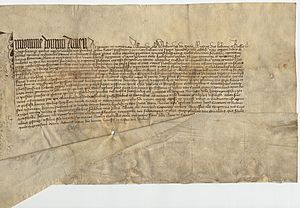
Vilnius has always been a multicultural city. Its languages changed over centuries. In medieval Lithuania, Lithuanian was the main spoken language. However, it was not often used in writing, except for religious texts.
Ruthenian became the main language for official documents in the Grand Duchy of Lithuania. This was from the 14th to the mid-17th century. Latin and Polish were also widely used. Polish eventually replaced Ruthenian in written documents.
At the court of Sigismund II Augustus, Polish and Lithuanian were spoken. In 1552, Sigismund ordered that announcements in Vilnius be made in Lithuanian, Polish, and Ruthenian. Minority groups like Jews and Tatars used their own languages among themselves. Today, Lithuanian is the official language of Lithuania.
Dressing Up: Fashion in Vilnius
In the 16th and 17th centuries, people in Vilnius wore special clothes. These included long, wide-sleeved jackets called kontuszes. They were often decorated with fur. Buttons were made of pearls, corals, and diamonds. Rich townspeople wore luxurious clothing. This made the nobility jealous. Laws were even made to control what people could wear.
By the late 1700s, men shaved their beards and wore short hair. They wore open-front tailcoats and waistcoats. Women's clothing followed Western European styles. In the early 1900s, fashion continued to follow Western trends. The Vilnius Model House was set up in 1961 to promote clothing and footwear.
The annual Mados infekcija (Fashion Infection) is Lithuania's largest fashion show. It started in 1999. Lithuanian clothing designer Juozas Statkevičius often presents his shows in Vilnius.
Celebrating Together: Holidays and Festivals
Catholic holidays like Christmas and Easter are widely celebrated in Vilnius. On February 16, Lithuania celebrates its independence. On March 11, it celebrates the restoration of its independence. Special events and religious services take place on these days. On January 12, bonfires are lit to remember the January Events.
Kaziuko mugė (Saint Casimir's Fair) is held every March. It attracts many visitors and craftspeople. Easter palms (Verbos) are a symbol of the fair. Capital Days (Sostinės dienos) is Vilnius' biggest music and culture festival. It takes place from August 30 to September 1. The Vilnia river is dyed green every year for Saint Patrick's Day. During the annual Vilnius Culture Night, artists hold events and performances.
How Vilnius is Run: Administration
City Government: Who Leads Vilnius?
Before 1378, Vilnius was ruled by special representatives. Later, a city council, called a magistrate, took over. This council reported to the ruler. In times of war, a voivode led the city. The city government was based at Vilnius Town Hall.
The magistrate managed the city's money. They collected taxes and made sure there was enough grain. They also acted as judges for building issues and took care of craftspeople. In 1522, the ruler gave magistrates the power to approve workshop rules. They also had to protect the city with armed guards.
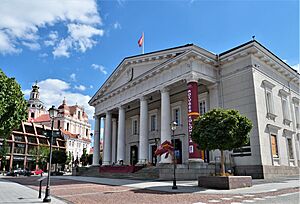
The main city leader was a Catholic vaitas. This person was the Grand Duke's representative. They led city council meetings and judged criminal cases. By the 16th century, the city council had 12 burgomasters and 24 councilors. Half were Catholic, and half were Orthodox. Wealthy citizens chose the members.
Under the Russian Empire, the city council was replaced by a city duma. After the Soviet occupation, Vilnius became the capital of the Lithuanian Soviet Socialist Republic.
Vilnius City Municipality: How the City Works Today
The Vilnius City Municipality is the local government. It is one of 60 municipalities of Lithuania. It includes Vilnius city, the town of Grigiškės, and nearby villages.
The Vinius City Municipal Council was created in 1990. Its members are elected every four years. Since 2011, independent candidates can run. The city's mayor is elected directly by the people since 2015. Remigijus Šimašius was the first directly elected mayor.
City Neighborhoods: Elderships of Vilnius
Elderships are like municipal districts. Vilnius has 21 elderships, based on neighborhoods:
- Verkiai – includes Baltupiai, Jeruzalė, Santariškės, Balsiai, and Visoriai
- Antakalnis – includes Valakampiai, Turniškės, and Dvarčionys
- Pašilaičiai – includes Tarandė
- Fabijoniškės – includes Bajorai
- Pilaitė
- Justiniškės
- Viršuliškės
- Šeškinė
- Šnipiškės
- Žirmūnai – includes Šiaurės miestelis
- Karoliniškės
- Žvėrynas
- Grigiškės – a town
- Lazdynai
- Vilkpėdė – includes Vingis Park
- Naujamiestis – includes bus and train stations
- Senamiestis (Old Town) – includes Užupis
- Naujoji Vilnia – includes Pavilnys and Pūčkoriai
- Paneriai – includes Trakų Vokė and Gariūnai
- Naujininkai – includes Kirtimai, Salininkai, and Vilnius International Airport
- Rasos – includes Belmontas and Markučiai
| Eldership | Area (km2) | Population | Density (per km2) |
|---|---|---|---|
| Antakalnis | 77.2 | 39,257 | 510 |
| Fabijoniškės | 4.1 | 37,006 | 9,000 |
| Grigiškės | 7.1 | 10,335 | 1,500 |
| Justiniškės | 3.0 | 25,956 | 8,700 |
| Karoliniškės | 4.0 | 24,751 | 6,200 |
| Lazdynai | 9.9 | 30,945 | 3,100 |
| Naujamiestis | 4.9 | 28,157 | 5,700 |
| Naujininkai | 41.1 | 30,030 | 730 |
| Naujoji Vilnia | 39.3 | 36,800 | 940 |
| Paneriai | 84.8 | 11,149 | 130 |
| Pašilaičiai | 7.9 | 40,384 | 5,100 |
| Pilaitė | 13.9 | 28,234 | 2,000 |
| Rasos | 16.3 | 10,230 | 630 |
| Senamiestis (Old Town) | 4.5 | 21,782 | 4,800 |
| Šeškinė | 4.4 | 28,137 | 6,400 |
| Šnipiškės | 3.1 | 16,474 | 5,300 |
| Verkiai | 55.7 | 50,754 | 910 |
| Vilkpėdė | 10.8 | 19,325 | 1,800 |
| Viršuliškės | 2.5 | 13,877 | 5,600 |
| Žirmūnai | 5.7 | 43,453 | 8,600 |
| Žvėrynas | 2.6 | 12,089 | 4,700 |
Vilnius District Municipality: Beyond the City Limits
The Vilnius District Municipality is one of Lithuania's largest. It covers 2,129 square kilometres (822 sq mi). It has 23 elderships and over 1,000 villages. There are also five towns in the district. It shares a border with Belarus.
The district has many different nationalities. About 52 percent are Poles, and 33 percent are Lithuanians. The rest are Russians, Belarusians, and others. Most people in the district live in villages. The Vilnius district has Lithuania's highest hills.
Palm Sunday is celebrated in the district. Special Easter palms, called verbos, are made from dried flowers. Medininkai Castle and the Liubavas Manor mill are famous historical sites.
Keeping Vilnius Safe: Special Services
Police in Vilnius are led by the Vilniaus apskrities vyriausiasis policijos komisariatas. Their main job is to keep public order and safety.
Firefighters in Vilnius are managed by the Vilniaus apskrities priešgaisrinė gelbėjimo valdyba. They respond to fire incidents.
Emergency medical services are provided by Vilniaus greitosios medicinos pagalbos stotis. This service started in 1902. The emergency number for all services in Lithuania, including Vilnius, is 112.
City Views: Urbanism and Architecture
Building Vilnius: Urban Planning and Architecture Styles
The Old Town covers about 3.6 km2 (1.4 sq mi). Its history goes back to the Neolithic period. A wooden castle was built around 1000 AD. This was at the meeting point of the Neris and Vilnia rivers. The settlement grew into a town in the 13th century. Around 1323, Vilnius became the capital of the Grand Duchy of Lithuania.
By the 15th century, the Grand Duchy stretched from the Baltic to the Black Sea. The historic center has three castles and was once surrounded by a wall. Streets are narrow, but large squares were later developed. Pilies Street is the main road. It connects the Palace of the Grand Dukes with Vilnius Town Hall. Other streets have palaces, churches, and shops.
Historic buildings show different styles. These include Gothic, Renaissance, Baroque, and classical architecture. The many churches and palaces show Vilnius' multicultural past.
Lithuania became Christian in 1387. But Eastern Orthodoxy and Judaism were also important. This led to the building of the Orthodox Cathedral of the Theotokos and the Great Synagogue of Vilna.
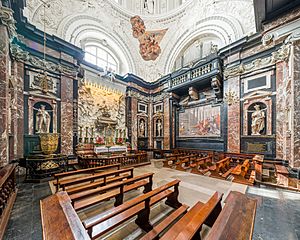
Disasters caused buildings to be rebuilt in the Vilnian Baroque style. This style later influenced the whole Grand Duchy. Italian artists designed the Chapel of Saint Casimir. The Lithuanian architect Laurynas Gucevičius was known for his classical designs.
The Old Town was named a UNESCO World Heritage Site in 1994. It is known for keeping its medieval street plan. Some areas were damaged during wars. For example, the Great Synagogue was destroyed after World War II.
Vilnius covers 401 km2 (155 sq mi). About one-fifth is developed, and the rest is green space and water. The city is known as one of Europe's "greenest" capitals.
Hidden Depths: Crypts of Vilnius
Important Lithuanian Catholics are buried in the crypts of Vilnius Cathedral. Grand Duke Alexander Jagiellon and Queen Elizabeth of Austria are buried there. The heart of Grand Duke Władysław IV Vasa is also there. These crypts have some of the oldest frescoes in Lithuania. They were painted in the late 14th or early 15th century.
Where People Live: Housing in Vilnius
Vilnius Old Town and Užupis have fancy homes. Apartments there often have views of famous churches. They have high ceilings and unique layouts. These flats can cost a lot of money. However, traffic and parking issues make some wealthy people prefer houses outside the city center. They choose areas like Balsiai or Pilaitė. About 21,000 people live in the Old Town.
Valakampiai and Turniškės are very nice neighborhoods. They have private houses surrounded by pine forests. Important people like the president live there. Some houses cost millions of euros. Žvėrynas also has luxurious private houses near Vingis Park.
Neighborhoods around the Old Town are popular with middle-class residents. These include Antakalnis, Žirmūnai, and Naujamiestis. They have different types of flats and green spaces. The government supports renovating old apartments.

Further out, neighborhoods like Lazdynai and Karoliniškės have more affordable housing. But they have longer commutes and older apartment buildings.
The Šnipiškės eldership has seen a lot of new development. It was first mentioned in 1536. A wooden bridge was built over the Neris river, and a suburb grew around it. In the 18th century, the Church of St. Raphael the Archangel was built there.
In the 1960s, Šnipiškės was renamed the New City Centre. It got its first pedestrian zone. Many new buildings were constructed before 1990. In the early 2000s, the new Vilnius city municipality building led to more construction. This included Europa Square with a shopping center and tall office buildings.
Experts say that housing sales reached record highs in 2019. This was because people's incomes increased. However, many young adults still live with their parents.
People of Vilnius: Demographics
| Historical population | ||||||||||||||||||||||||||||||||||||||||||||||||||||||||||||||||||||||||||||||||||||||||||||||||||||||||||||||||||||||||||||||||||||||||||||||||||||||||||||||||||||||||||||||||||||||||||||||||||||||||
|---|---|---|---|---|---|---|---|---|---|---|---|---|---|---|---|---|---|---|---|---|---|---|---|---|---|---|---|---|---|---|---|---|---|---|---|---|---|---|---|---|---|---|---|---|---|---|---|---|---|---|---|---|---|---|---|---|---|---|---|---|---|---|---|---|---|---|---|---|---|---|---|---|---|---|---|---|---|---|---|---|---|---|---|---|---|---|---|---|---|---|---|---|---|---|---|---|---|---|---|---|---|---|---|---|---|---|---|---|---|---|---|---|---|---|---|---|---|---|---|---|---|---|---|---|---|---|---|---|---|---|---|---|---|---|---|---|---|---|---|---|---|---|---|---|---|---|---|---|---|---|---|---|---|---|---|---|---|---|---|---|---|---|---|---|---|---|---|---|---|---|---|---|---|---|---|---|---|---|---|---|---|---|---|---|---|---|---|---|---|---|---|---|---|---|---|---|---|---|---|---|
|
|
|
||||||||||||||||||||||||||||||||||||||||||||||||||||||||||||||||||||||||||||||||||||||||||||||||||||||||||||||||||||||||||||||||||||||||||||||||||||||||||||||||||||||||||||||||||||||||||||||||||||||
¹ Sharp decline after the Vilnius uprising (1794); ² Decline of population due to Napoleonic wars and the aftermath; ³ Sharp decline of population of Vilnius because of World War I and the aftermath during the clashes around Vilnius. These resulted in evacuation of Russian military, bureaucracy and the majority of its Russian inhabitants from Vilnius in 1915, as well as fleeing or evacuation of other Vilnius inhabitants of various communities (mostly Jewish and Lithuanian) to Russia and rural parts of Lithuania; ⁴ Rise of population due to influx of Polish and Jewish war refugees and migration of Lithuanian bureaucracy, students from temporary capital Kaunas and other localities in Lithuania; ⁵ Sharp decline of population after atrocities of World War II and The Holocaust
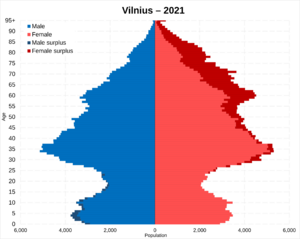
Ancient settlements were found in Vilnius dating back to 10,000 BC. The area where the Neris and Vilnia rivers meet was very populated. Some historians believe Vilnius was a city during the time of King Mindaugas. It is known that Vilnius existed as a city during the times of Traidenis and Vytenis. It was first mentioned as a capital in 1323 in letters from Gediminas.
Vilnius became a multicultural city. In the 14th century, it had a Lithuanian part and a Ruthenian part. By the 16th century, German merchants, artisans, Jews, and Tatars lived there. Many Italian and Swiss artisans also lived in the city. Because so many nations lived there, Vilnius was called the "Babylon of Europe" in the 16th-18th centuries.
After World War II, the number of ethnic Lithuanians in Vilnius grew. After independence in 1990, the ethnic Lithuanian population increased even more. In 2021, 67.44 percent of the population was Lithuanian.
Money and Innovation: Vilnius' Economy
Vilnius is the economic heart of Lithuania. The average income per person in the metropolitan area is almost €30,000. The city's budget reached €1.0 billion in 2022. In early 2024, the average monthly salary in Vilnius was €2,478.7 before taxes.
Lithuania's economy grows unevenly. Vilnius and Kaunas counties produce 42 and 20 percent of the national GDP, respectively. From 2014 to 2016, the Vilnius region grew by 4.6 percent.
More new homes are being built in Vilnius and its suburbs. Demand for housing is strong due to rising wages. Most foreign investment in Lithuania goes to Vilnius and Kaunas. Vilnius Industrial Park is for businesses and factories.
Smart Ideas: Science and Research in Vilnius
In 1675, Vilnius resident Tito Livio Burattini first suggested the term "metre" as a unit of length. The Vilnius University Astronomical Observatory was founded in 1753. It was one of Europe's first observatories. Marcin Odlanicki Poczobutt led its reconstruction. He started astronomical observations in 1773.
Sunrise Valley Science and Technology Park was founded in 2003. Over 20,000 students study there. 5,000 scientists do research in its centers.
The Centre for Physical Sciences and Technology (FTMC) is Lithuania's largest science research place. It specializes in laser technology, nuclear physics, and nanotechnology. It has over 250 laboratories. Lithuania makes over 50 percent of the world's ultrashort pulse lasers.
The Vilnius University Life Sciences Centre opened in 2016. It has three institutes and many students. It also has a business incubator for life science companies. Santara Valley focuses on medicine and biopharmaceuticals.
Vilnius University rector Jonas Kubilius was known for his work in probabilistic number theory. Marija Gimbutas from Vilnius developed the Kurgan hypothesis. Kavli Prize winner Virginijus Šikšnys invented CRISPR-Cas9 genetic editing.
Digital World: Information Technology in Vilnius
Vilnius is attractive to foreign companies because of its skilled workers and good infrastructure. Schools like the Vilnius University Faculty of Mathematics and Informatics train specialists. IT jobs pay well. In 2018, Lithuania's IT sector produced €2.296 billion, much of it in Vilnius.
Vilnius Tech Park is the largest IT startup hub in the Baltic and Nordic countries. It brings together startups and tech companies. fDi Intelligence ranked Vilnius as the top city for tech startup investment in 2019.
Vilnius had the world's fastest internet speed in 2011. It is still one of the fastest. Vilnius Airport has very fast airport Wi-Fi. The National Cyber Security Centre of Lithuania is in Vilnius. It protects government organizations from internet attacks.
Since 2017, computer programming is taught in primary schools. Vilnius is also a popular place for fintech companies. This is because Lithuania has flexible rules for e-money licenses. Google Payment Lithuania and Revolut have licenses and offices in Vilnius. Europe's first international blockchain center opened in Vilnius in 2019.
Money Matters: Finance and Banking in Vilnius
Vilnius is Lithuania's financial center. The Ministry of Finance works to ensure economic growth. The Bank of Lithuania helps keep the financial system stable. The Nasdaq Vilnius stock exchange is in the K29 business center.
The National Audit Office of Lithuania helps manage public money. The State Tax Inspectorate collects taxes.
In 2023, 13 banks had licenses in Lithuania. Six were branches of foreign banks. Most of Lithuania's financial system is made up of banks from Nordic countries. The two largest banks, SEB bankas and Swedbank, are supervised by the European Central Bank.
Learning in Vilnius: Education
Schools for All Ages: Primary and Secondary Education
In Lithuania, primary and lower secondary education is required. Children start school at age six. Education is mandatory until age 16. Public primary and secondary education is free. Vilnius also has private schools. The Ministry of Education, Science and Sports is in Vilnius.
The Cathedral School of Vilnius, mentioned in 1397, is the oldest known Lithuanian school. Vilnius Vytautas the Great Gymnasium, founded in 1915, was the first Lithuanian gymnasium in eastern Lithuania. In 2018, Vilnius had 120 schools with over 61,000 students. Four of the five best-rated schools in Lithuania are in Vilnius. The Vilnius Lyceum is number one.
Ethnic minorities in Lithuania have their own schools. Vilnius has schools where lessons are taught in minority languages. This includes Polish and Russian. Vilnius also has 11 vocational schools.
The National M. K. Čiurlionis School of Art is the only 12-year art school in the country. Most school graduates in Vilnius go on to study at universities or colleges. In 2021, over half of young adults in Lithuania had a university degree.
Vilnius has nine international schools. These include the International School of Vilnius and the British International School of Vilnius.
Higher Learning: Tertiary Education in Vilnius
In 1773, the Commission of National Education was created. It oversaw schools and Vilnius University. It is seen as Europe's first education ministry.
Vilnius has many universities. The largest and oldest is Vilnius University. Its main campus is in the Old Town. It is ranked among the top 500 universities in the world. The university works on projects with UNESCO and NATO. It offers master's programs in English and Russian. It also has programs with other European universities. Vilnius University has 14 faculties.
Other universities include Mykolas Romeris University and Vilnius Gediminas Technical University. Specialized schools with university status include the General Jonas Žemaitis Military Academy of Lithuania and the Lithuanian Academy of Music and Theatre. The museum at the Vilnius Academy of Arts has about 12,000 artworks.
Books and Knowledge: Libraries in Vilnius
The Vilnius city municipality central library runs public libraries. It has 16 branches, including one for children's literature. Many libraries offer free computer classes.
The Martynas Mažvydas National Library of Lithuania was founded in 1919. It collects and preserves Lithuania's written heritage. It also provides library services to the public.
The Wroblewski Library of the Lithuanian Academy of Sciences is open to everyone. It had over 3.7 million books in 2015.
Every university and college in Lithuania has a library for its students and professors. The National Open Access Scientific Communication and Information Center opened in 2013. It has over 800 study spaces.
Faith and Beliefs: Religion in Vilnius
| Religion | People | % |
|---|---|---|
| Roman Catholic | 350,797 | 65.5% |
| Eastern Orthodox | 47,827 | 8.9% |
| Old Believers | 5,593 | 1.0% |
| Evangelical Lutheran | 1,594 | 0.3% |
| Evangelical Reformed | 1,186 | 0.2% |
| Sunni Muslim | 798 | 0.2% |
| Jewish | 796 | 0.2% |
| Greek Catholic | 167 | <0.1% |
| Karaites | 139 | <0.1% |
| Other | 5,050 | 0.9% |
| None | 47,655 | 8.9% |
| No response | 74,029 | 13.8% |
By the 17th century, Vilnius was known for its many religions. A book from 1600 said Vilnius had Catholics, Orthodox, Lutherans, Jews, and Muslims. In that century, some said Vilnius had more churches than almost any other city.
Vilnius is the center of the Roman Catholic Archdiocese of Vilnius. It has many Catholic churches and monasteries. Many Christian saints and martyrs are connected to the city. These include Saint Casimir and Faustina Kowalska. The churches show Gothic, Renaissance, Baroque, and neoclassical styles.
Vilnius has had an Eastern Orthodox presence since the 12th century. The Russian Orthodox Monastery of the Holy Spirit is near the Gate of Dawn. Many Old Believers, who separated from the Russian Orthodox Church, settled in Lithuania. Vilnius also has Protestant churches, like Lutherans and Baptists.
The ancient Lithuanian religion, which worships nature gods like Perkūnas, is gaining interest. The Romuva religion established a branch in Vilnius in 1991.
Jewish and Karaite Heritage in Vilnius
Vilnius was called "Yerushalayim D'Lita" (the Jerusalem of Lithuania). It was a global center for Jewish study. Rabbi Eliyahu Kremer, known as the Vilna Gaon, was a major Jewish scholar. The Vilna Edition Shas, a widely used version of the Talmud, was published in Vilnius in 1886.
Jewish life in Vilnius was destroyed during the Holocaust. A memorial stone marks the former Vilna Ghetto. The Vilna Gaon Museum of Jewish History tells the story of Lithuanian Jewish life. The site of Vilnius's largest synagogue, destroyed during World War II, is being excavated by archaeologists.
The Karaites are a Jewish group who came from Crimea. They have restored their kenesas (places of worship) in Vilnius.
Holy Places: Pilgrimage Sites in Vilnius
Since Lithuania became Christian in 1387, Vilnius has been a Christian pilgrimage site. The Vilnius Pilgrimage Centre helps organize pilgrimages. Many places in Vilnius are linked to miracles or important Christian events. The Chapel of the Gate of Dawn is visited by thousands of pilgrims each year. This chapel has a 17th-century painting called Our Lady of the Gate of Dawn. It is believed to be miraculous.
The Divine Mercy Sanctuary is another pilgrimage site. It has a Divine Mercy image. The Divine Mercy devotion started in Vilnius. Saint Faustina Kowalska began her mission here. The first Divine Mercy image was painted in 1934. It hangs in the Divine Mercy Sanctuary.
The Church of St. Philip and St. Jacob has a painting called the Mother of God of Lukiškės. Miracles have been reported there.
Three Crosses is a monument in the city. A legend says it marks where Franciscan friars were killed. Verkiai Calvary is Lithuania's second-oldest calvary. It was built from 1662 to 1669. It has chapels, gates, and a bridge. Most chapels were destroyed by Soviet authorities in 1962. They were rebuilt from 1990 to 2002. Pilgrimages are held regularly.
The Church Heritage Museum has the oldest and largest collection of religious artifacts. Vilnius is the only Baltic city with an Apostolic Nunciature. This is where popes stay when they visit.
Green Spaces and Landmarks: Parks, Squares, and Cemeteries
Almost half of Vilnius is covered by green spaces. These include parks, gardens, and nature reserves. The city has lakes where people swim and barbecue in summer. Thirty lakes and 16 rivers cover 2.1 percent of Vilnius. Some have sand beaches.
Vingis Park is the city's largest. It hosted big rallies when Lithuania sought independence in the 1980s. Parts of the annual Vilnius Marathon run along the Neris river. The green area near the White Bridge is popular for outdoor events.
Cathedral Square in the Old Town is surrounded by historic sites. Lukiškės Square is the largest. It is bordered by government buildings and embassies. A large statue of Vladimir Lenin was removed from its center in 1991. Town Hall Square is a center for fairs and celebrations. The city's Christmas tree is displayed there. State ceremonies are often held in Daukanto Square.
Bernardinai Garden is near Gediminas' Tower. It was restored in 2013. It hosts concerts, festivals, and exhibitions. Chiune Sugihara Sakura Park was created in 2001. A Japanese garden opened in 2023.
Rasos Cemetery, consecrated in 1801, is where Jonas Basanavičius and other signers of Lithuania's 1918 Act of Independence are buried. Two of the city's three Jewish cemeteries were destroyed by Soviet authorities. The Bernardine Cemetery, established in 1810, is being restored. Antakalnis Cemetery, established in 1809, has memorials for soldiers and those killed during the January Events.
Visiting Vilnius: Tourism
In 2018, over 1.2 million visitors stayed in Vilnius. Most were foreigners. Many came from Belarus, Germany, Poland, Russia, and Latvia. A survey found that 48 percent of visitors were seeing Vilnius for the first time. Most planned their trips themselves. Many visited to learn about the city's history.
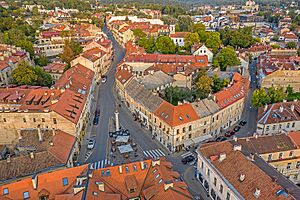
Vilnius' Tourist Information Centres had over 119,000 visitors in 2018. The highest-rated tourist services were restaurants, old-town attractions, and hotels. Vilnius is one of the few European capitals that allows hot air ballooning over the city. In 2019, Vilnius was ranked as the best value European capital for visitors.
Staying in Vilnius: Hotels
Lithuania is part of the European Hotelstars Union. Vilnius has six five-star hotels. All are in the Old Town. The Kempinski Hotel is considered the most luxurious.
In 2018, most visitors stayed in mid-range hotels. Vilnius had 82 hotels, eight motels, and 40 other places to stay in 2019. This offered over 6,800 rooms and 15,200 beds.
Staying Active: Sports in Vilnius
Vilnius has several basketball teams. BC Wolves started playing in 2022. The biggest team is BC Rytas. They play in the Lithuanian Basketball League (LKL) and international games. They won the ULEB Cup in 2005 and the EuroCup in 2009. Their home arena is the 2,500-seat Jeep Arena. Big games are played at the 10,000-seat Twinsbet Arena.
Vilnius also has football teams. FK Žalgiris is the main team. They play at the 5,000-seat LFF Stadium. A new Lithuania National Stadium is being built. The 28-court SEB Arena is the largest tennis complex in Central Europe. It is home to Lithuania's tennis and squash teams.
Olympic swimming champions Lina Kačiušytė and Robertas Žulpa are from Vilnius. The city has several public swimming pools. The Lazdynai Swimming Pool is the only Olympic-size swimming pool. Vilnius is home to many sports federations. The annual international Vilnius Marathon has thousands of participants.
Getting Around: Transport in Vilnius
The Neris river is not used for regular water transport. Vilnius Airport is Lithuania's largest. It serves about 50 cities in 25 countries. The airport is 5 km (3.1 mi) from the city center. It has a direct link to the Vilnius railway station. The railway station connects to Minsk, Kaliningrad, Moscow, and Saint Petersburg.
Vilnius is the start of the A1 motorway. This highway crosses Lithuania, connecting Vilnius, Kaunas, and Klaipėda. The A2 connects Vilnius and Panevėžys. Other highways also start from Vilnius.
Riding the City: Bus and Trolleybus Service
The bus and trolleybus networks are run by Vilniaus viešasis transportas. There are over 60 bus routes and 18 trolleybus routes. Six are rapid bus routes, and there is one night bus route. The trolleybus network is one of Europe's largest. Over 250 buses and 260 trolleybuses carry about 500,000 passengers each workday. The first bus routes started in 1926. Trolleybuses were introduced in 1956.
In 2007, an electronic ticket system was launched. Passengers could buy a card and load money onto it. In 2012, these cards were replaced by Vilnius Citizen Cards (Vilniečio Kortelė). Single-trip tickets were replaced by 30- and 60-minute tickets. A mobile app for tickets was introduced in 2014.
Buses are low-floor Volvo and Mercedes-Benz buses. Trolleybuses are made by Solaris. Some older Škoda vehicles are still used. In 2017, Vilnius started a big upgrade. It bought 250 new low-floor buses. By mid-2018, 60 percent of public buses were new. They had free Wi-Fi and chargers. New trolleybuses were also added.
Since 2017, a 30-minute ticket costs €0.65. A 60-minute ticket costs €0.90. A ticket bought on board costs €1.00. Discounts are available for students and the elderly.
A Vilnius Metro and an electric tram have been suggested. In 2018, the government approved a metro project.
-
Solaris Urbino 18 bus and Škoda 26Tr Solaris trolleybuses in Vilnius
Staying Healthy: Healthcare in Vilnius
When Vilnius was part of the Grand Duchy of Lithuania, it had public bathhouses. In 1518, the first špitolė (a hospital-like place) was set up. It treated people who were sick, old, or poor.
The Brotherhood of Saint Roch ran hospitals and shelters from 1708 to 1799. They hired doctors, surgeons, and nurses. They cared for pregnant women, abandoned children, and patients with various illnesses.
In 1805, the Vilnius Medical Society was founded. It was the first medical society in Eastern Europe. The same year, they opened a teaching hospital as part of Vilnius University's medical faculty.
The Ministry of Health in Vilnius is in charge of Lithuanian healthcare. People in Vilnius pay compulsory health insurance. This covers 6.98 percent of their salary. It gives free healthcare to insured people. Some groups, like the disabled and students, do not pay this tax.
Vilnius University Hospital Santaros Klinikos and the Vilnius City Clinical Hospital are the main hospitals. Vilnius also has eight polyclinics and many private healthcare places.
News and Entertainment: Media in Vilnius
The first Lithuanian weekly newspaper, Kurier Litewski, was published in Vilnius from 1760 to 1763. Vilnius is home to many newspapers and magazines. These include Lietuvos rytas and 15min.
The Vilnius TV Tower broadcasts television to the city. The most-watched TV networks in Lithuania are based in Vilnius. These include LRT televizija and TV3.
Vilnius' first radio station, Rozgłośnia Wileńska, started broadcasting in 1927. M-1, Lithuania's first commercial radio station, began broadcasting from Vilnius in 1989. Other radio stations also broadcast from Vilnius. The Lithuanian Union of Journalists is headquartered in Vilnius.
Global Connections: Twin Towns and Sister Cities
Vilnius is connected with many cities around the world. These are called twin towns or sister cities.
 Aalborg, Denmark
Aalborg, Denmark Almaty, Kazakhstan
Almaty, Kazakhstan Astana, Kazakhstan
Astana, Kazakhstan Chicago, United States
Chicago, United States Dnipro, Ukraine
Dnipro, Ukraine Donetsk, Ukraine
Donetsk, Ukraine Duisburg, Germany
Duisburg, Germany Erfurt, Germany
Erfurt, Germany Gdańsk, Poland (1998)
Gdańsk, Poland (1998) Guangzhou, China
Guangzhou, China Joensuu, Finland
Joensuu, Finland Kyiv, Ukraine
Kyiv, Ukraine Kraków, Poland
Kraków, Poland Łódź, Poland
Łódź, Poland Madison, United States
Madison, United States Pavia, Italy
Pavia, Italy Reykjavík, Iceland
Reykjavík, Iceland Riga, Latvia
Riga, Latvia Salzburg, Austria
Salzburg, Austria Taipei, Taiwan
Taipei, Taiwan Tallinn, Estonia
Tallinn, Estonia Tbilisi, Georgia
Tbilisi, Georgia Warsaw, Poland
Warsaw, Poland
Vilnius also had twin and friendly towns until 2022, but these connections have changed.
Famous Faces: Notable People from Vilnius
Many famous people were born in Vilnius, lived there, or studied at Vilnius University. You can find a full list of these people in the List of people from Vilnius. Some people have also been made honorary citizens of Vilnius.
Images for kids
See also
 In Spanish: Vilna para niños
In Spanish: Vilna para niños


